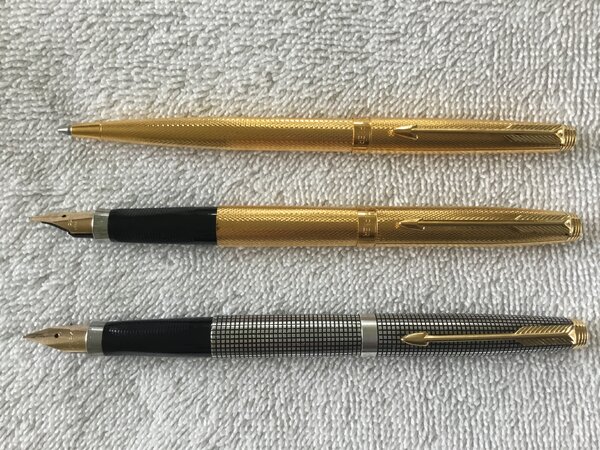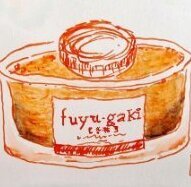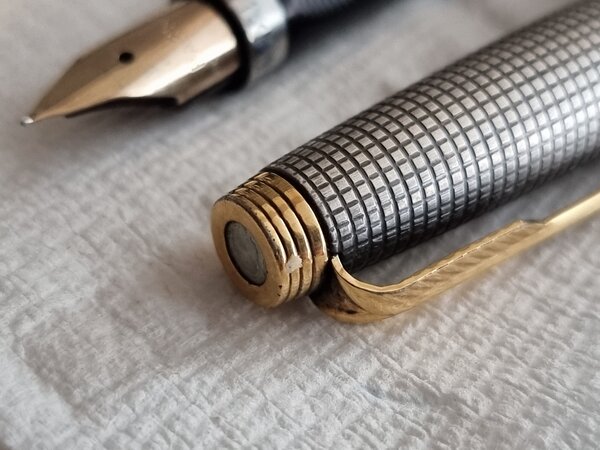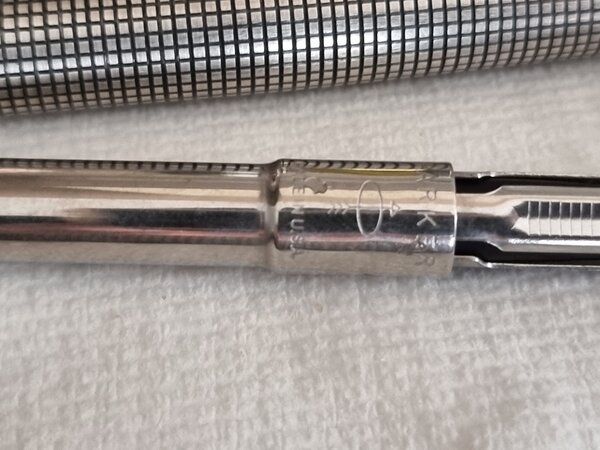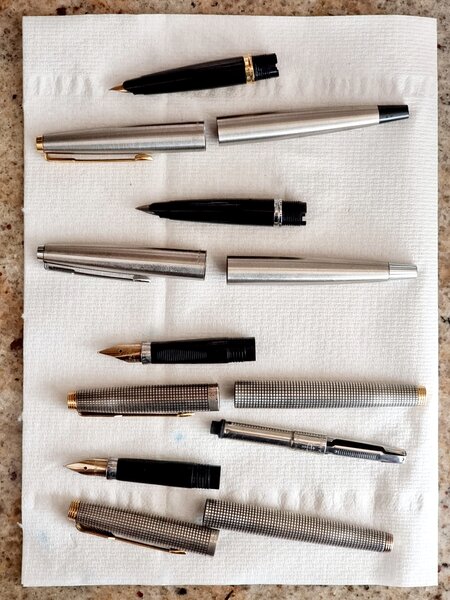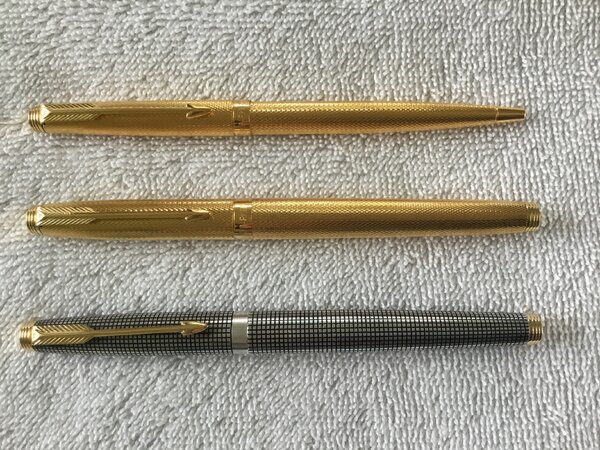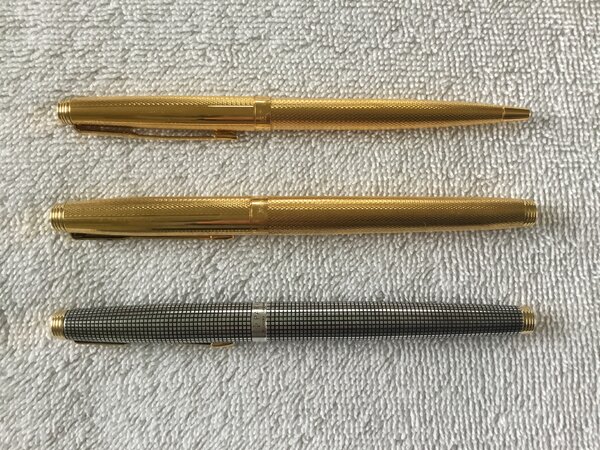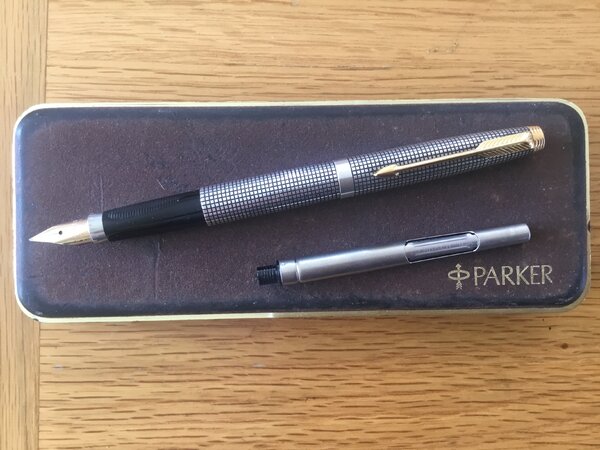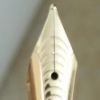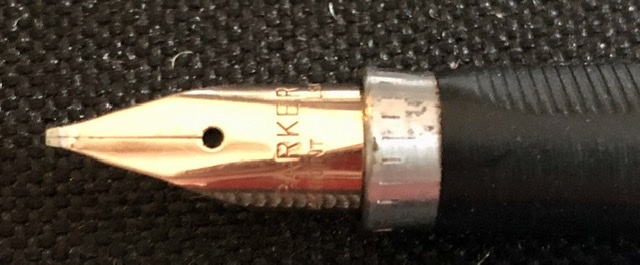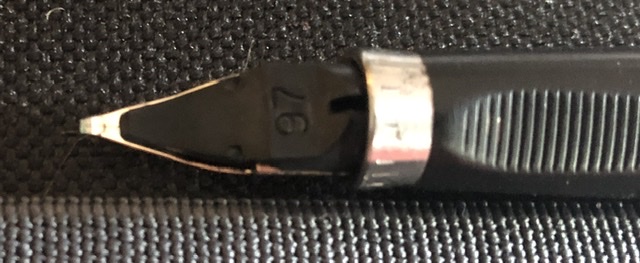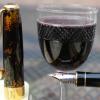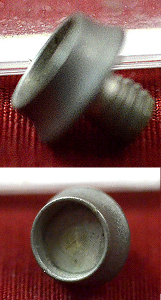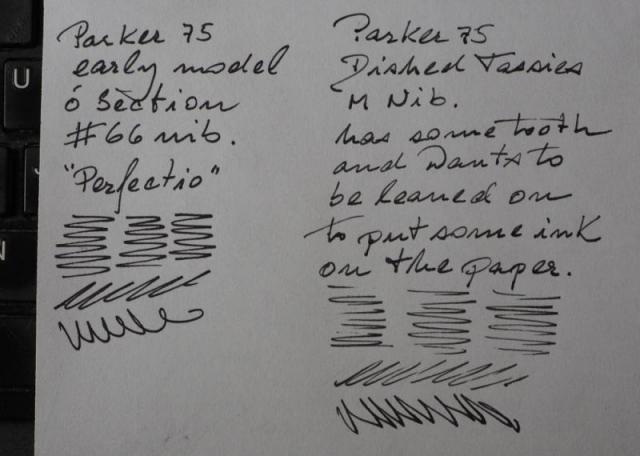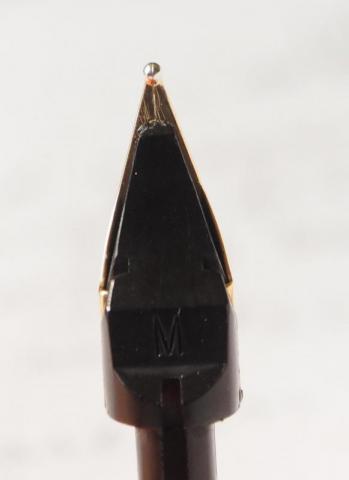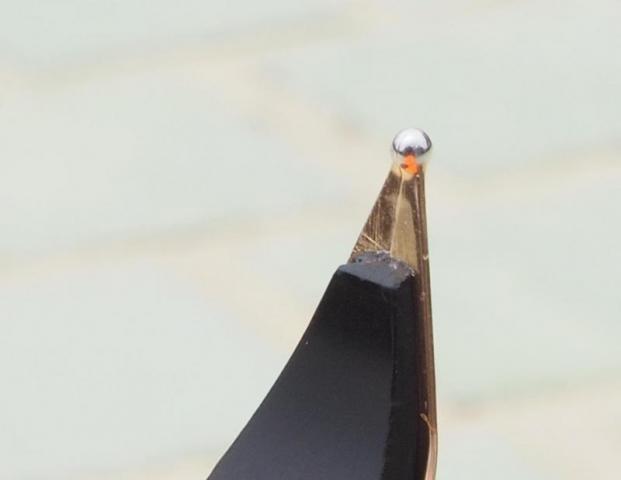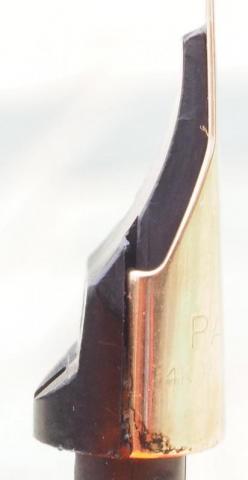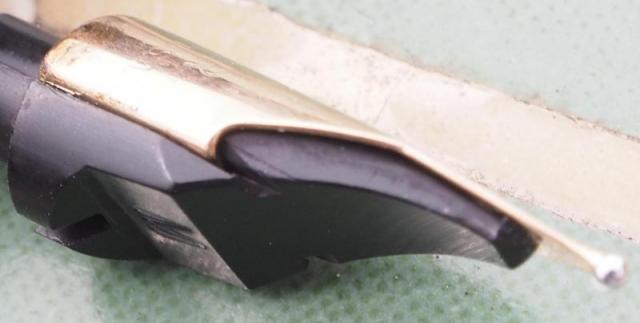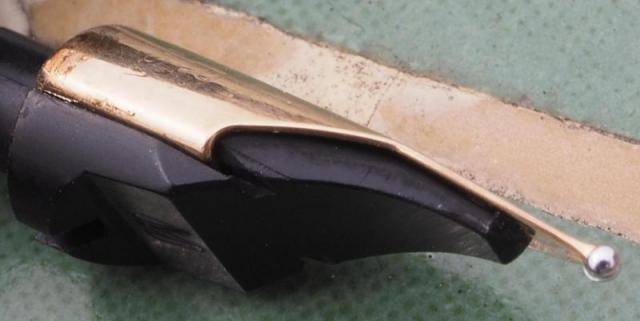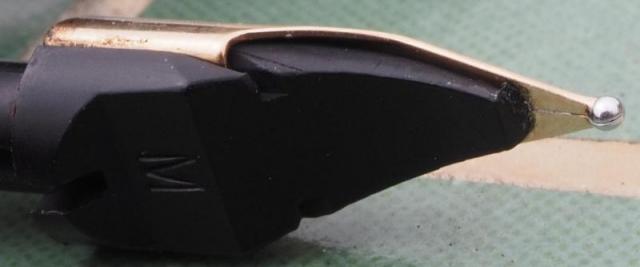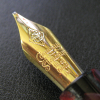Search the Community
Showing results for tags 'parker 75'.
-
I had the good fortune of picking up this Parker felt tip pen at the flea market last Sunday at a sumgai price. While clearly all titanium, and with the classic red barrel jewel, I initially assumed this is a T-1 model. But I am confused by the lack of a similar red jewel on the cap. I read...
- 8 replies
-
- parker t-1
- parker 75
-
(and 1 more)
Tagged with:
-

French Maker’s Hallmark for Parker Pens on nib of Parker 75
Mercian posted a gallery image in FPN Image Albums
From the album: Mercian’s pens
This mark - ‘PP’ separated by an upward-pointing arrow - is the hallmark for ‘Parker Pens’. It is on the 14k gold nib on my Parker 75 that was made at Parker’s factory in Méru, France, in 1984 Q1. The fact that it is enclosed within a losange shows, according to French law, that it is a ‘...© Mercian
- 0 B
- x
-
From the album: Mercian’s pens
Parker 75 ‘Place Vendôme’ BP, in gold-plated ‘Grain d’Orge’ finish. Made in France. Date code IE (1988 Q3). Bought in a shop in mid-1989, so I am confident about this being its date of production. Parker 75 ‘Place Vendôme’ FP, in gold-plated ‘Grain d’Orge’ finish. Made in France. Date...
- 0 B
- x
-
Hi, I currently have two Parker 75 pens, and I love them. I am thinking of buying a factory-italic nib to use in them (or perhaps another 75 that has a factory italic nib). My handwriting is rather small, so I am conscious that I won’t be able to use an italic nib if its width...
-
First time I've ever seen a gold section ring with a zero mark. On a Parker 75 godron with the old flat ended tassies.
- 2 replies
-
- parker 75
- section ring
-
(and 2 more)
Tagged with:
-
Hi friends, I have always admired the Parker 75 fountain pen and over a period of time, have collected a modest assortment of these in various finishes. However, this one pen was eluding me for quite a while- the Parker 75 Cisele first year model with the metal threaded secti...
- 14 replies
-
- parker 75
- parker 75 cisele
- (and 4 more)
-
And I came across this auction which ended a few moments ago, on eBay, where this Parker 75 Florence Sterling Silver FP sold for a whopping $908. I have never come across such a price for a similar model in the past, or perhaps, I need to educate myself more on the desirability of this m...
- 5 replies
-
- parker 75
- parker 75 florence
- (and 5 more)
-
From the album: OldTravelingShoe's Random Pics of Fountain Pens (2)
© (c) 2022 by OldTravelingShoe. All rights reserved.
- 0 B
- x
-
From the album: OldTravelingShoe's Random Pics of Fountain Pens (2)
© (c) 2022 by OldTravelingShoe. All rights reserved.
- 0 B
- x
-
From the album: OldTravelingShoe's Random Pics of Fountain Pens (2)
© (c) 2022 by OldTravelingShoe. All rights reserved.
- 0 B
- x
-
From the album: Mercian’s pens
I have taken this photo to show an interesting ‘feature’ of my gold-plated 75s in ‘Grain d’Orge’ finish. The ‘dish’ plate at the centre of the cap-tassie of the BP is, like the ‘dish’ plate at the centre of the cap-tassie of the Ciselé Sterling Silver 75 FP, golden in colour. But the ‘dish...
- 0 B
- x
-
From the album: Mercian’s pens
Parker 75 ‘Place Vendôme’ BP, in gold-plated ‘Grain d’Orge’ finish. Made in France. Date code IE (1988 Q3). Bought in a shop in mid-1989, so I am confident about this being its date of production. Parker 75 ‘Place Vendôme’ FP, in gold-plated ‘Grain d’Orge’ finish. Made in France. Da...
- 0 B
- x
-
From the album: Mercian’s pens
Parker 75 ‘Place Vendôme’ BP, in gold-plated ‘Grain d’Orge’ finish. Made in France. Date code IE (1988 Q3). Bought in a shop in mid-1989, so I am confident about this being its date of production. Parker 75 ‘Place Vendôme’ FP, in gold-plated ‘Grain d’Orge’ finish. Made in France. Da...
- 0 B
- x
-
From the album: Mercian’s pens
This Parker 75 was ‘Made in USA’. I think it dates to the late 1970s, but it may be early-1970s (like me). It has a 14k gold ‘F’ nib that was also ‘Made in USA’.
- 0 B
- x
-
Hello! It has been quite some time since I have posted on here. I hope all are doing well. I stumbled upon a GoPens catalog from March 2007 which contained a "1975 Parker 75 “Ecossais” in Black" (item #28). Would anyone browsing this forum happen to know the story behind this pen, and th...
-
Difference Between Parker 75 And 180 Ball Pens
thx1138 posted a topic in It Writes, But It Is Not A Fountain Pen ....
As the title says, can anyone please give me some guidance on the difference between Parker 75 and 180 ball pens? They seem almost identical. I'm sure there must be some difference but I cant really find one other than some of the 180 ball pens have smooth tassies. -
This is a Parker 75 medium stub ciselé of around 1968-1971. Writing sample: The line thickness it produces is about 0.9 mm in width. This width is comfortable for writing characters of medium size (see also the writing comparison). The pen’s triangular section is thin, but it is very...
-

Just Discovered A Parker 75 With 14K Fine Italic Nib
bbbdco posted a topic in Fountain & Dip Pens - First Stop
With the current COVID-19 crisis, I have been spending a lot of time at home. I have rediscovered all my old calligraphy pens and have been relearning the art of fine writing. I was still missing a few items, and I came across an old box in my basement. I found several old items of ink, nibs, etc. I... -
To the point: any advice before I start using a Parker 75 bought used? One with the thinner section, fine size nib. Longer story: I'd given up on the 75 given that I have no way of trying them in person, and they are apparently thinner than Sonnets, of which I have two. But... I came across one fo...
- 33 replies
-
- parker 75
- milleraies
-
(and 3 more)
Tagged with:
-
I have just inherited my father's Parker 75, a sterling silver ciselé which the Parker Penography website says started being offered in 1966. It has a few battle-scars and needs a seriously good clean but appears to be in good condition, except for one thing. The pen won't insert into the cap. I loo...
-

Fixing A Parker 75 Bicentennial (Aka "i Might Be In Over My Head")
alexwi posted a topic in Repair Q&A
Hi, I got a Parker 75 Bicentennial whose cap jiggles. Don't know if that's the right term, but when capped, the cap doesn't stay in place, and it moves up and down about half a millimeter. The issue is the inner plastic cap, which needs to be replaced, as the cap behaves the same when I put it on...- 8 replies
-
- parker 75
- parker 75 cap
- (and 3 more)
-
The Parker 75 “Cisele” & Sheaffer Silver Imperial
SimiaeParvus posted a topic in Fountain Pen Reviews
The Parker 75 “Cisele” & Sheaffer Silver Imperial After a few years in the hobby of collecting fountain pens I’ve reached a point, where my acquisition of pens gravitates towards a preferred style of pens. After some deliberation, I´ve come to the long term goal of acquiring a pen in sterling silv...- 8 replies
-
- parker 75 “cisele”
- sheaffer silver imperial
- (and 4 more)
-
Hi, I just got a Parker 75 with a Medium nib, possibly 1970's, as the nib's marked with a letter and the tassies are dished, but it's incredibly dry (see sample). I already left the nib and the section soaking all night (not much came out), and then a few hours this morning, in warm water with a...
-
A friend of mine gave me this wonderful Parker 75, last month. It served him well for years, but he's never been a fountain pen enthusiast, so he never cleaned it. As I received it I washed it all thoroughly, except for the probably most clogged part: under the nib (pic related) Do you know how can...
- 17 replies
-
- parker 75
- broken nipple
-
(and 1 more)
Tagged with:
-
One of my earliest memories of pens being special and valued was a Parker ballpoint and pencil set my grandfather used to wear in his shirt pocket. I always thought they were special and I guess I coveted a set like that for my very own. He had them for many years, but they seem to have been los...







